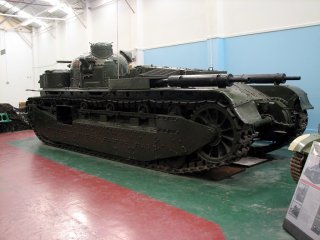Nazi Germany Built a Tank That Had Three Turrets and Four Guns
Though these tanks were not useful in actual combat, they allowed the German army to secretly gain experience in tanking—a skill that would prove to be extremely valuable during the Second World War.
During the interwar years, multi-turreted tanks were all the rage. Post-war, the British developed the A1E1 dual-turreted tank, which formed the basis for a number of other inter-war multi-turreted tank designs—including one secretly developed in the Soviet Union based on a stolen British design.
After the armistice ending World War One, Germany was forbidden from building or developing tanks, so their heavy tank development project was conducted in secret, codenamed Großtraktor, or Heavy Tractor, to disguise the project’s true purpose.
The German design was helped by British A1E1 plans that were acquired via spy, an officer in the British Army and Nazi sympathizer. Since Germany was barred from tank development, they had to conduct training outside of Germany, and set up a clandestine tank training camp near Kazan, in the Soviet Union. Many of the tankers that trained there went on and became influential in Germany’s tank corps during the Second World War.
Heavy and Slow
These heavy tanks were quite large for their time. Though they weighed nearly 25 tons, their armor protection was not spectacular, just half an inch to three quarters of an inch thick. This modest protection package was quite poor, and would not have offered the crew much protection.
Despite the abysmal armoring the tank actually had a respectable amount of firepower for its time, and came equipped with a whopping three turrets that had four guns. The main turret was armed with a 75 millimeter gun that could fire a high-explosive shell, and had a secondary 37 millimeter gun that could shoot armor piercing and high explosive rounds. The secondary gun was fitted either next to the main gun, or above it. The guns could not aim independently.
The tank also had two identical turrets at front and rear that were essentially modified Panzer I turrets. These turrets were armed with a general purpose MG 34 machine gun. The front turret was below the main turret, while the rear turret was on the tank’s back left corner. Because of the tank’s large internal volume, the crew was six in total, presumably a commander, driver, three gunners, and a loader.
Still, the tanks were quite slow, and could barely make 15 miles per hour on paved roads, while cross-country performance was even worse. Range was very limited, just 75 miles or so.
Into the Fray
These three-turreted tanks were more useful as propaganda than in actual combat, though three were deployed during the German invasion of Norway. On the way to combat, two of the heavy tanks experienced mechanical problems, preventing them from fighting. The one tank that did make it to the front didn’t do well. Using anti-tank rifles, the defenders were able to score a number of hits on the tank, killing one tanker. The tank beat a hasty retreat and was combat ineffective.
Though these tanks were not useful in actual combat, they allowed the German army to secretly gain experience in tanking—a skill that would prove to be extremely valuable during the Second World War.
Caleb Larson holds a Master of Public Policy degree from the Willy Brandt School of Public Policy. He lives in Berlin and writes on U.S. and Russian foreign and defense policy, German politics, and culture.

